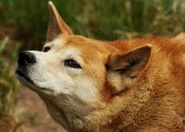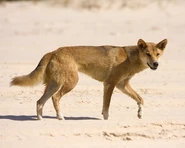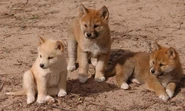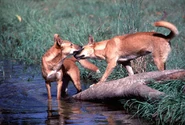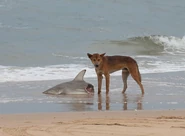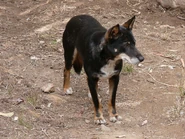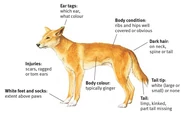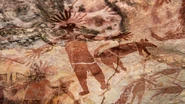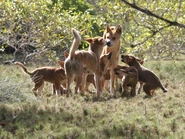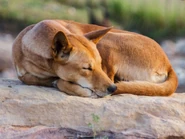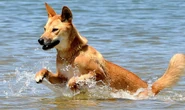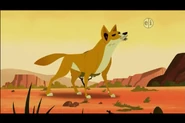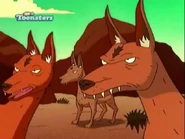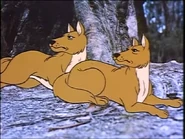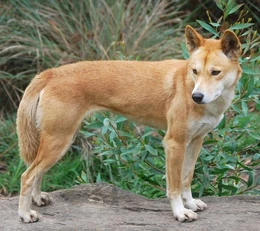
The dingo (Canis lupus dingo) is a wild dog found in Australia. Its exact ancestry is debated, but dingoes are generally believed to be descended from semi-domesticated dogs from East or South Asia, which returned to a wild lifestyle when introduced to Australia. Both dingo and domestic dog are classified as a subspecies of Canis lupus in Mammal Species of the World.
The dingo's habitat ranges from deserts to grasslands and the edges of forests. Dingoes will normally make their dens in deserted rabbit holes and hollow logs close to an essential supply of water. The dingo is the largest terrestrial predator in Australia, and plays an important role as an apex predator. However, the dingo is seen as a pest by livestockfarmers due to attacks on animals. Conversely, their predation on rabbits, kangaroos and rats may be of benefit to graziers.
For many Australians, the dingo is a cultural icon. The dingo is seen by many as being responsible for thylacine extinction on the Australian mainland about two thousand years ago, although a recent study challenges this view. Dingoes have a prominent role in the culture of Aboriginal Australians as a feature of stories and ceremonies, and they are depicted on rock carvings and cave paintings. Despite being an efficient hunter, it is listed as vulnerable to extinction. It is proposed that this is due to susceptibility to genetic pollution: a controversial concept according to which interbreeding with domestic dogs may dilute the dingo's unique adaptations to the Australian environment.
Barking[]
Compared to most domestic dogs, the bark of a dingo is short and monosyllabic, and is rarely used. Barking was observed to make up only 5% of vocalisations. Dog barking has always been distinct from wolf barking. Australian dingoes bark mainly in swooshing noises or in a mixture of atonal and tonal sounds. In addition, barking is almost exclusively used for giving warnings. Warn-barking in a homotypical sequence and a kind of "warn-howling" in a heterotypical sequence have also been observed. The bark-howling starts with several barks and then fades into a rising and ebbing howl and is probably (similar to coughing) used to warn the puppies and members of the pack. Additionally, dingoes emit a sort of "wailing" sound, which they mostly use when approaching a wateringhole, probably to warn already present dingoes.
According to the present state of knowledge, it is not possible to get Australian dingoes to bark more frequently by putting them in contact with other domestic dogs. However, German zoologist Alfred Brehm reported a dingo that learned the more "typical" form of barking and how to use it, while its brother did not. Whether dingoes bark or bark-howl less frequently in general is not certain.
Howling[]
Dingoes have three basic forms of howling (moans, bark-howls and snuffs) with at least 10 variations. Usually, three kinds of howls are distinguished: long and persistent, rising and ebbing, and short and abrupt.
Observations have shown that each kind of howling has several variations, though their purpose is unknown. The frequency of howling varies with the season and time of day, and is also influenced by breeding, migration, lactation, social stability and dispersal behaviour. Howling can be more frequent in times of food shortage, because the dogs become more widely distributed within their home range.
Additionally, howling seems to have a group function, and is sometimes an expression of joy (for example, greeting-howls). Overall howling was observed less frequently in dingoes than among grey wolves. It may happen that one dog will begin to howl, and several or all other dogs will howl back and bark from time to time. In the wilderness, dingoes howl over long distances to attract other members of the pack, to find other dogs, or to keep intruders at bay. Dingoes howl in chorus with significant pitches, and with increasing number of pack-members, the variability of pitches also increases. Therefore, it is suspected that dingoes can measure the size of a pack without visual contact. Moreover, it has been proposed that their highly variable chorus howls may generate a confounding effect in the receivers by making pack size appear larger.
Other forms of communication[]
Growling, making up approximately 65% of the vocalisations, is used in an agonistic context for dominance, and as a defensive sound. Similar to many domestic dogs, a reactive usage of defensive growling is only rarely observed. Growling very often occurs in combination with other sounds, and has been observed almost exclusively in swooshing noises (similar to barking).
During observations in Germany, dingoes were heard to produce a sound that observers have called Schrappen. It was only observed in an agonistic context, mostly as a defence against obtrusive pups or for defending resources. It was described as a bite intention, during which the receiver is never touched or hurt. Only a clashing of the teeth could be heard.
Aside from vocal communication, dingoes communicate, like all domestic dogs, via scent marking specific objects (for example, Spinifex) or places (such as waters, trails and hunting grounds) using chemical signals from their urine, feces and scent glands. Males scent-mark more frequently than females, especially during the mating season. They also scent-rub, whereby a dog rolls its neck, shoulders, or back on something that is usually associated with food or the scent markings of other dogs. Unlike wolves, dingoes can react to social cues and gestures from humans.
Behavior[]
Dingoes tend to be nocturnal in warmer regions, but less so in cooler areas. Their main period of activity is around dusk and dawn. The periods of activity are short (often less than one hour) with short times of resting. Dingoes have two kinds of movement: a searching movement (apparently associated with hunting) and an exploratory movement (probably for contact and communication with other dogs).
In general, dingoes are shy towards humans. However, there are reports of dingoes that were agitated by the presence of humans, such as around camps in national parks, near streets or suburbs. According to studies in Queensland, the wild dogs (dingo hybrids) there, move freely at night through urban areas and cross streets and seem to get along quite well.
Dietary Habits[]
About 170 species (from insects to buffalo) have been identified as part of the dingo's diet. In general, livestock seems to make up only a small proportion of their diet. In continent-wide examinations, 80% of the diet of wild dogs consisted of 10 species: red kangaroo, swamp wallaby, cattle, dusky rat, magpie goose, common brushtail possum, long-haired rat, agile wallaby, European rabbit and the common wombat. This narrow range of major prey indicates these wild dogs are rather specialised, but in the tropical rainforests of northeastern Australia, dingoes are supposed to be opportunistic hunters of a wide range of mammals. In certain areas, they tend to specialise on the most common prey, with a preference for medium- to large-sized mammals. Their consumption of domestic cats has also been proven. Non-mammalian prey is irregularly eaten and makes up only 10% of the dingo's diet. Big reptiles are only rarely captured, at least in eastern Australia, although they are widespread. It is possible that especially large monitor lizards are too defensive and well-armed, or they are simply able to flee fast enough into dens or climb trees.
Dietary composition varies from region to region. In the gulf region of Queensland, feral pigs and agile wallabies are the dingo's main prey. In the rainforests of the north, the main prey consists of magpie geese, rodents and agile wallabies. In the southern regions of the Northern Territory, the dogs mainly eat European rabbits, rodents, lizards and red kangaroo; in arid Central Australia, rabbits, rodents, lizards, red kangaroo and cattle carcasses; and in the dry northwest, eastern wallaroos and red kangaroo. In the deserts of the southwest, they primarily eat rabbits, and in the eastern and southeastern highlands, they eat wallabies, possums and wombats.
To what extent the availability of rabbits influences the composition of the diet cannot be clarified. However, because rabbit haemorrhagic disease killed a large part of the Australian rabbit population at the end of the 20th century, it is suspected that the primary prey of the dogs has changed in the affected areas. Also, on Fraser Island, fish have been proven to be a part of the dingo diet. The main prey species, though, are bandicoots and several rodents. Dingoes also eat a lot of echidnas, crabs, small skinks, fruits and other plants, as well as insects (mostly beetles). During these observations, only 10% of the examined faeces-samples contained human garbage (in earlier studies 50% were reported).
When scavenging for food, wild dogs (presumably, all dogs free to roam, not just dingoes) primarily eat cattle and kangaroo carcasses. Dingoes in coastal regions regularly patrol the coast for dead fish, seals, penguins and other washed-up birds.
Dingoes in general drink one litre of water a day in the summer and about half a litre a day in winter. During the winter in arid regions, dingoes could potentially live from the liquid in the bodies of their prey, as long as the number of prey is sufficient. Similarly, weaned pups in Central Australia are able to draw their necessary requirements of liquid from their food. There, regurgitation of water by the females for the pups was observed. During lactation, females have no higher need of water than usual, since they consume the urine and feces of the pups and therefore recycle the water and keep the den clean. 17 tracked dingoes have survived 22 days without water in the winter.
Hunting Behavior[]
Dingoes often kill by biting the throat, and they adjust their hunting strategies to suit circumstances. For larger prey, due to strength and potential danger, two or more individuals are needed to bring down the prey. Such group formations are unnecessary when hunting rabbits or other small prey.
Kangaroo hunts are probably more successful in open areas than in places with high densities of vegetation, and juvenile kangaroos are killed more often than adults. Dingoes typically hunt large kangaroos by having lead dingoes chase the quarry toward their waiting packmates, which are skilled at cutting corners in chases. In one area of Central Australia, dingoes hunt kangaroos by chasing them toward a wire fence that hindered their escape.
Birds can be captured when they do not fly or fail to take off fast enough. Dingoes also steal the prey of eagles and the coordinated attack of three dingoes for killing a large monitor lizard has been observed. Reports state that some dingoes live almost entirely on human food through stealing, scavenging, or begging. In fact, dingoes are well known for such behaviour in some parts of Australia. It is suspected that this might cause the loss of hunting strategies or a change in the social structures.
During studies at the Fortescue River in the mid-1970s, observation showed that most of the studied dingoes learned to hunt and kill sheep very quickly, even without prior contact with sheep. Although the dingoes killed many sheep at that time, they still killed and ate kangaroos.
During the early 1990s, wild dogs were observed to have an extraordinarily high success rate when killing sheep, and did not have to hunt in a coordinated manner to achieve success. Often, a dog may chase and outrun a single sheep, only to turn away suddenly and chase another. Therefore, only a small proportion of the injured or killed sheep and goats are eaten, which seems to be the rule and not the exception. The dog probably falls into some kind of "killing spree," due to the rather panicked and uncontrolled flight behaviour of the sheep, which run in front of the dingoes time and again and, therefore, cause one attack after another. Dingoes often attack sheep from behind during the sheep's flight, which causes injuries to the sheep's hind legs. Rams are normally attacked from the side – probably in order to avoid the horns – or sometimes on the testicles. Inexperienced dingoes, or those that kill "for fun," sometimes cause significant damage to the sheep's hind legs, which often causes death.
Nearly all dingo attacks on cattle and water buffalo are directed against calves. Hunting success depends on the health and condition of the adult bovines and on their ability to defend their calves. The defence behaviour of the mother can be sufficient to fend off an attack. Therefore, the basic dingo tactics of attack are distracting the mother, rousing the herd/group and waiting (sometimes for hours), and testing of the herd to find the weakest members.
While locating a cattle herd, dingoes have been observed to make several feint attacks, during which they concentrate on the calves at first then, later on, attack the mothers to distract them. Thereupon, the dingoes retreat and wait at a distance from the herd until the rest of the cows have gathered their calves and move on. During another observed attack, "subgroups" of a dingo pack took turns in attacking and resting, until the mother was too tired to effectively defend her calf. Dingoes have been observed hunting a water buffalo with an estimated weight of 200 kg, and taking turns biting the buffalo's legs during the chase.
Social Behavior[]
The dingo's social behaviour is about as flexible as that of a coyote or gray wolf, which is perhaps one of the reasons it was initially believed that the dingo was descended from the Indian wolf. While young males are often solitary and nomadic in nature, breeding adults will often form a settled pack. However, in areas of the dingo's habitat with a widely spaced population, breeding pairs remain together, apart from others.
Where conditions are favourable among dingo packs, the pack is stable with a distinct territory and little overlap between neighbors. The size of packs often appears to correspond to the size of prey that appears in the pack's territory. Desert areas have smaller groups of dingoes with a more loose territorial behaviour and sharing of the water sites. It has been noted that the average monthly pack size was between three and twelve members.
Similar to other canids, a dingo pack largely consists of a mated pair, their current year's offspring, and occasionally a previous year's offspring. There are dominance hierarchies both between and within males and females, with males usually being more dominant than females. However, a few exceptions have been noted in captive packs. During travel, while eating prey, or when approaching a water source for the first time, the breeding male will be seen as the leader, or alpha. Subordinate dingoes will approach a more dominant dog in a slightly crouched posture, ears flat and tail down, to ensure peace in the pack. Establishment of artificial packs in captive dingoes have failed.
